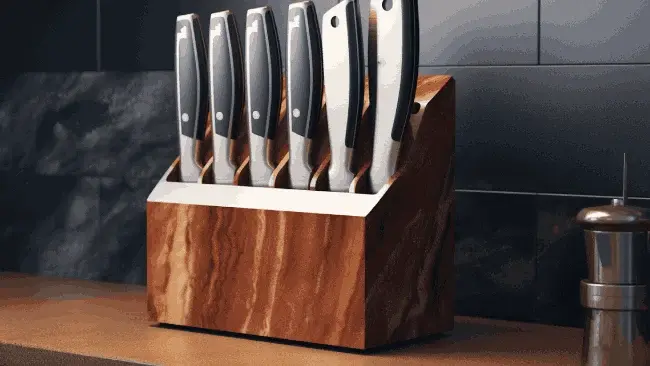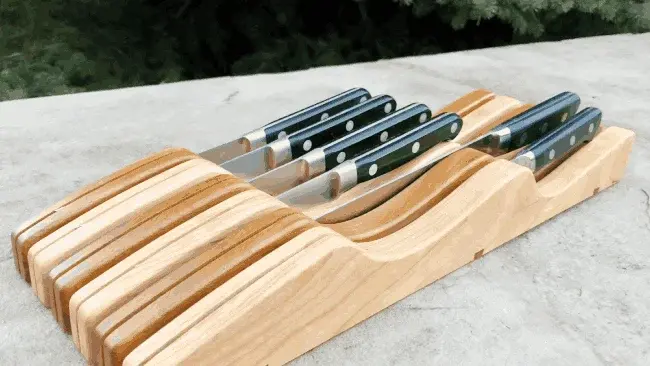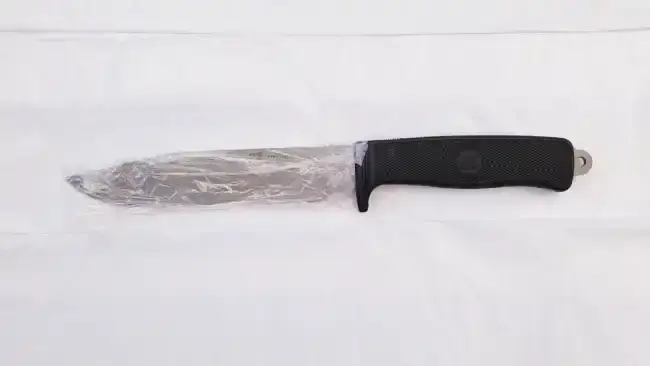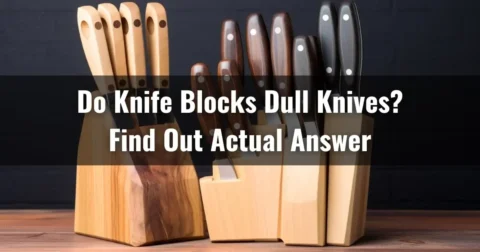Storing your kitchen knives for the long haul is vital to maintaining their sharpness and overall quality. You should consider protecting your knives as an investment in the culinary arena.
There are some fantastic kitchen knife storage options that not only ensure the safety of your blades but also contribute to an organized and efficient kitchen.
One excellent choice for storing kitchen knives is magnetic knife strips, which provide both practicality and a sleek appearance.
To store your knives on a magnetic strip, ensure they are clean and dry, then gently slide each knife onto the magnetic surface for secure attachment.
Another option is cork-lined knife holders, perfect for those seeking an organized and visually appealing setup. To use a cork-lined holder, ensure your knives are clean and dry before gently placing them in the designated slots or compartments.
We’ll explore some amazing kitchen knife storage options and explore how to store your kitchen knives with these options.
Jump to Section
How to Store Kitchen Knives Long Term: A Complete Guide

To store your kitchen knives long-term, there are several options available.
1. Magnetic Knife Strips
Magnetic knife strips are an excellent choice for long-term kitchen knife storage as they offer both practicality and a sleek appearance.
Before attaching the magnetic strip, you need to ensure that it is firmly fastened to the wall using appropriate screws and anchors. As a result, your knives remain secure and do not fall off accidentally.
To ensure your knives are ready for storage on the magnetic strip, you must ensure they are clean and dry. It is best to wipe each blade with a clean, dry cloth to remove any moisture or debris that could damage the blade over time.
You should place frequently used knives towards the top of the strip to ensure convenience, while the less often used ones should be placed at the bottom.
Also, it is necessary to ensure that all knives are evenly spaced to prevent them from touching and potentially causing damage.
To store your knives on the magnetic strip, slide each knife gently onto the magnetic surface, allowing it to attach firmly.
2. Cork-Lined Knife Holders
Another excellent choice is cork-lined knife holders, which many homeowners find useful for long-term knife storage and a unique way to organize your knives. When purchasing a cork-lined knife holder, ensure that it is an adequate size for the number and size of knives you have.
To prepare your knives for storage in a cork-lined knife holder, you must ensure that they are clean and completely dry. We suggest you gently wipe each blade with a soft cloth to remove any excess moisture or food residue that could cause damage to the blade over time.
Before storing the knives in the holder, gently place each knife into the designated slots or compartments, ensuring they fit comfortably without overcrowding. Consider organizing the knives by type or size for easy access and retrieval of the desired knife.
When storing the cork-lined knife holder, keep it in a location that is easily accessible from your workspace. Avoid placing heavy objects on top of the holder as it may cause damage to the cork lining, hindering the prevention of bacteria growth.
3. In-Drawer Knife Holders
An in-drawer knife holder is an excellent option to keep their knives out of sight and save counter space.

When choosing an in-drawer knife holder, ensure it fits comfortably in your kitchen drawer. Before placing the holder inside, ensure the drawer is clean and dry.
Like with cork-lined knife holders, cleaning and drying your knives before storing them in an in-drawer knife holder is vital.
To prevent accidents by knives, place them with the blade down within the holder, spaced apart to prevent them from scratching against each other.
4. Blade Protectors
Blade protectors are crucial for keeping your knives safe during extended periods of storage. They are available in a variety of sizes and types, so select ones that match your knives.
Before storing your knives on the protectors, thoroughly clean and dry them, removing any remaining moisture from the blades.
Once you have cleaned and dried your knives, slide them into their respective protectors, ensuring they fit securely. This snug fit will prevent unnecessary movement that could damage the blade.
Store your protected knives in a drawer for added protection, ensuring they stay in prime condition until their next use.
5. Knife Block
Knife blocks are another popular option for storing kitchen knives long-term. Materials like acacia, bamboo, and walnut are excellent choices for knife blocks due to their durability and aesthetics.
You should select a knife block that offers specific slots for the knives you own, matching each knife with its corresponding slot based on size and type.
To store your kitchen knives in a knife block, ensure they’re clean and dry. Organize them in designated slots by size or type and choose a block with labeled slots for easy identification.
Additionally, place the knife block on your kitchen counter within easy reach of your workspace.
6. Knife Bags
You can also consider using knife bags to store your kitchen knives long-term. They provide a convenient and secure option for keeping your knives organized and protected.
Knife bags are available in various sizes and styles, so choose one that can accommodate the number and size of your knives. Before storing your knives, ensure that the interior of the bag is clean and free from any debris.
Place each knife within the bag’s designated compartment, securing them with the closures or flaps provided. Organizing your knives by type or size is a good idea for easy retrieval.
Store the knife bag in a convenient location, such as a pantry or cupboard, and keep it away from extreme temperatures or humidity.
FAQ’s: How to Store Kitchen Knives Long Term
It has been our experience that many homeowners have questions regarding the storage of their kitchen knives. The following questions may be helpful to you.
How do I prevent corrosion when using blade protectors for knife storage?
When storing knives with blade protectors, you must ensure that the knives are dry and moisture-free, which can lead to corrosion over time.

Before placing your knives in the protectors, ensure they’re clean and completely dry. Any moisture left on the blades can cause rust to develop.
To further prevent corrosion, consider using blade protectors made of moisture-resistant materials like plastic or silicone. These materials act as a barrier between the blade and any potential sources of moisture.
You can also add desiccant packs to the storage container to help absorb excess moisture and maintain a dry environment.
Is it necessary to apply oil to my kitchen knives before storing them?
Applying a thin layer of oil to your kitchen knives before storing them helps protect against rust & corrosion and keep them sharp.
This maintenance practice is especially important for knives made from carbon steel. By oiling the blades, you create a barrier that prevents moisture from coming into contact with the metal, reducing the chances of rust formation.
Mineral-grade oil is recommended for this purpose, but cooking oil can also be used as a suitable alternative.
How often should I sharpen my knives in long-term storage to maintain their edge?
Sharpening your knives every 1-2 months is generally recommended to maintain their edge during long-term storage.
If you prefer an exceptionally sharp edge of a knife, you should hone them once a week. For professional chef’s knives, you can opt for professional sharpening once or twice a year.
However, if you’re comfortable with the task, you may sharpen them yourself every 2-3 months to ensure they stay in optimal cutting condition.
Conclusion
When you need to store your kitchen knives long-term, remember that the right storage method is crucial to maintain their sharpness and quality.
Whether you opt for magnetic knife strips, cork-lined holders, in-drawer solutions, blade protectors, knife blocks, or knife bags, each option has its advantages. Prioritize cleanliness and dryness before storing your knives, and consider organizing them by type or size for easy access.
To prevent corrosion, keep your knives moisture-free, and apply a thin layer of oil, especially for carbon steel blades, can be a wise move. By choosing the right storage and maintenance, you’ll safeguard your culinary investments and enjoy precise, safe cutting in your kitchen for a long time.





![Knife Block vs Magnetic Strip: 10 Differences [Explained]](https://tidytango.com/wp-content/uploads/2023/10/Knife-Block-vs-Magnetic-Strip-10-Differences-Explained-480x252.webp)